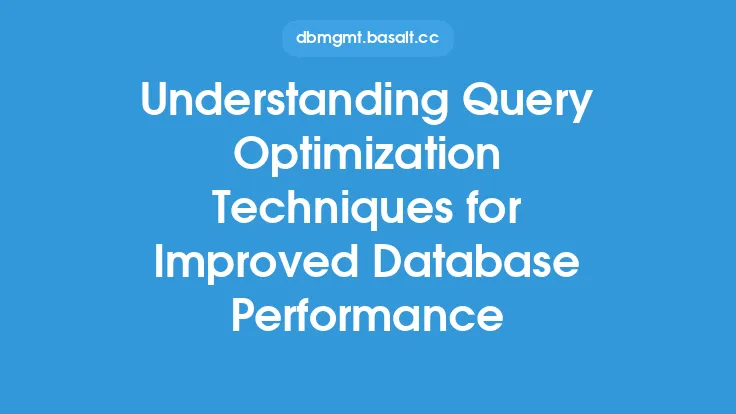Denormalization is a data modeling technique used to improve the performance of a database by intentionally deviating from the principles of data normalization. While data normalization is essential for ensuring data consistency and reducing data redundancy, it can sometimes lead to complex queries and slower performance. Denormalization techniques help to address these issues by allowing some degree of data redundancy and complexity in the database design.
Introduction to Denormalization
Denormalization involves deliberately violating the rules of data normalization to achieve better performance. This can be done by combining data from multiple tables into a single table, storing redundant data, or using summary tables to reduce the number of joins required. Denormalization is often used in data warehousing and business intelligence applications where query performance is critical. However, it requires careful consideration and planning to ensure that data consistency and integrity are maintained.
Types of Denormalization
There are several types of denormalization techniques, each with its own advantages and disadvantages. Some of the most common types of denormalization include:
- Pre-aggregation: This involves storing pre-calculated aggregate values, such as sums or averages, in a separate table. This can improve query performance by reducing the need for complex calculations.
- Pre-joining: This involves storing data from multiple tables in a single table, eliminating the need for joins. This can improve query performance by reducing the number of tables that need to be accessed.
- Data duplication: This involves storing duplicate data in multiple tables to improve query performance. This can be useful in situations where data is frequently accessed and updated.
- Summary tables: This involves creating separate tables to store summary data, such as totals or averages. This can improve query performance by reducing the need for complex calculations.
Benefits of Denormalization
Denormalization can provide several benefits, including:
- Improved query performance: Denormalization can improve query performance by reducing the number of joins required, eliminating the need for complex calculations, and storing pre-calculated aggregate values.
- Reduced data redundancy: Denormalization can reduce data redundancy by storing data in a single table, eliminating the need for duplicate data.
- Simplified data access: Denormalization can simplify data access by providing a single point of access to data, eliminating the need for complex queries.
- Improved data scalability: Denormalization can improve data scalability by allowing for the storage of large amounts of data in a single table, reducing the need for complex data partitioning.
Challenges of Denormalization
While denormalization can provide several benefits, it also presents several challenges, including:
- Data consistency: Denormalization can lead to data inconsistency if not properly managed. This can result in incorrect or outdated data being stored in the database.
- Data integrity: Denormalization can compromise data integrity if not properly managed. This can result in data being lost or corrupted.
- Data maintenance: Denormalization can make data maintenance more complex, requiring additional processes and procedures to ensure data consistency and integrity.
- Data scalability: Denormalization can limit data scalability if not properly managed. This can result in data becoming too large to be stored in a single table, requiring complex data partitioning.
Best Practices for Denormalization
To ensure that denormalization is effective and efficient, several best practices should be followed, including:
- Careful planning: Denormalization should be carefully planned to ensure that data consistency and integrity are maintained.
- Data analysis: Data should be carefully analyzed to determine the best denormalization technique to use.
- Data modeling: Data should be carefully modeled to ensure that denormalization is effective and efficient.
- Data testing: Data should be carefully tested to ensure that denormalization is working as expected.
- Data maintenance: Data should be regularly maintained to ensure that data consistency and integrity are maintained.
Tools and Technologies for Denormalization
Several tools and technologies are available to support denormalization, including:
- Database management systems: Database management systems, such as Oracle and Microsoft SQL Server, provide features and tools to support denormalization.
- Data warehousing tools: Data warehousing tools, such as Amazon Redshift and Google BigQuery, provide features and tools to support denormalization.
- Business intelligence tools: Business intelligence tools, such as Tableau and Power BI, provide features and tools to support denormalization.
- Data integration tools: Data integration tools, such as Informatica and Talend, provide features and tools to support denormalization.
Conclusion
Denormalization is a powerful technique for improving the performance of a database. By intentionally deviating from the principles of data normalization, denormalization can improve query performance, reduce data redundancy, simplify data access, and improve data scalability. However, denormalization requires careful planning, data analysis, data modeling, data testing, and data maintenance to ensure that data consistency and integrity are maintained. By following best practices and using the right tools and technologies, denormalization can be an effective and efficient way to improve database performance.





